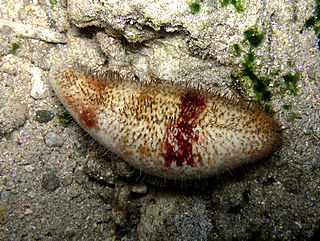In Greek mythology, Caerus was the personification of opportunity, luck and favorable moments. He was shown with only one lock of hair. His Roman equivalent was Occasio or Tempus. Caerus was the youngest son of Zeus. Caerus and Tyche became lovers after Caerus neglected to overthrow his father as everyone thought he would.

The lion's mane jellyfish, also known as the giant jellyfish, arctic red jellyfish, or the hair jelly, is one of the largest known species of jellyfish. Its range is confined to cold, boreal waters of the Arctic, northern Atlantic, and northern Pacific Oceans. It is common in the English Channel, Irish Sea, North Sea, and in western Scandinavian waters south to Kattegat and Øresund. It may also drift into the southwestern part of the Baltic Sea. Similar jellyfish – which may be the same species – are known to inhabit seas near Australia and New Zealand. The largest recorded specimen was measured off the coast of Massachusetts in 1865 and had a bell with a diameter of 210 centimetres and tentacles around 36.6 m (120 ft) long. Lion's mane jellyfish have been observed below 42°N latitude for some time in the larger bays of the East Coast of the United States.

Actinopyga is a genus of sea cucumbers found in coastal waters in tropical and temperate regions.

Stipa capillata is a perennial bunchgrass species in the family Poaceae, native to Europe and Asia.

Cyanea is a genus of jellyfish, primarily found in northern waters of the Atlantic and Pacific Oceans and southern Pacific waters of Australia and New Zealand, there are also several boreal, polar, tropical and sub-tropical species. Commonly found in and associated with rivers and fjords. The same genus name has been given to a genus of plants of the Hawaiian lobelioids, an example of a parahomonym.
Coleophora capillata is a moth of the family Coleophoridae. It is found in Turkey.

Hemilophini is a tribe of longhorn beetles of the subfamily Lamiinae.
Tyrinthia is a genus of longhorn beetles of the subfamily Lamiinae, containing the following species:
Tyrinthia dionae is a species of beetle in the family Cerambycidae. It was described by Martins and Galileo in 2004. It is known from Colombia.
Tyrinthia moroiuba is a species of beetle in the family Cerambycidae. It was described by Martins and Galileo in 1991. It is known from Colombia and Costa Rica.
Tyrinthia turuna is a species of beetle in the family Cerambycidae. It was described by Martins and Galileo in 1993. It is known from Colombia.
Tyrinthia colombiana is a species of beetle in the family Cerambycidae. It was described by Galileo and Martins in 2009. It is known from Colombia.
Tyrinthia lycinella is a species of beetle in the family Cerambycidae. It was described by Henry Walter Bates in 1881. It is known from Costa Rica and Honduras.
Tyrinthia obtusa is a species of beetle in the family Cerambycidae. It was described by Henry Walter Bates in 1881. It is known from Colombia.
Tyrinthia photurina is a species of beetle in the family Cerambycidae. It was described by Henry Walter Bates in 1885. It is known from Panama.
Tyrinthia scissifrons is a species of beetle in the family Cerambycidae. It was described by Henry Walter Bates in 1866. It is known from French Guiana, Brazil and Trinidad.
Tyrinthia xanthe is a species of beetle in the family Cerambycidae. It was described by Henry Walter Bates in 1881. It is known from Costa Rica, Panama and Nicaragua.
Tyrinthia klugii is a species of beetle in the family Cerambycidae. It was described by James Thomson in 1868. It is known from Colombia.

Caladenia capillata, commonly known as white daddy long legs or wispy spider orchid, is a plant in the orchid family Orchidaceae and is endemic to Victoria and South Australia. It is a ground orchid with a single hairy leaf and up to three cream-coloured to yellowish flowers with long, thread-like petals and sepals and a very small labellum.

Actinopyga capillata, the hairy sea cucumber, is a species of sea cucumber in the family Holothuriidae. It is found in the tropical West Indo-Pacific region, having a disjunct range, with the main population in island groups in the western Indian Ocean, and a separate population in the Philippines.





